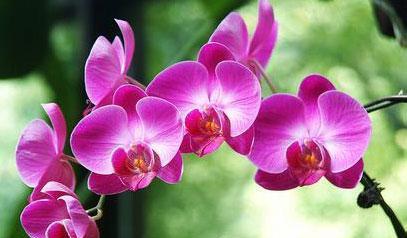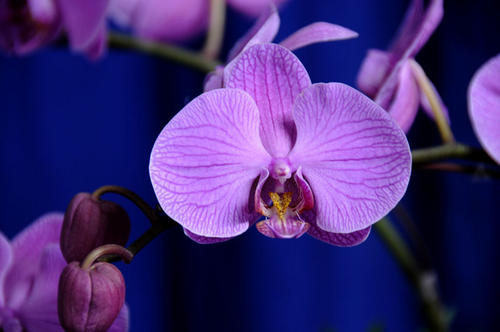Moth orchids profile
Written by Maggie
Sep 09 2021

Moth Orchids, also called Phalaenopsis Orchid, are popular with flower lovers because of their unique flowers and long flowering period. Therefore, many flower lovers will plant them in pots at home or in their offices. Moth Orchids are also one of the more widely potted flowers in the home.
Moth orchids picture
Moth orchids morphological characteristics
Moth orchids (Phalaenopsis Orchid) stem is very short, often encased in leaf sheaths. Leaf blade os slightly fleshy, often 3-4 or more, upper green, abaxially purple, elliptic, oblong or sickle-oblong, 10-20 cm long and 3-6 cm wide, apex acute or obtuse, base cuneate or sometimes askew, with a short and broad sheath.
Inflorescence of Moth orchids (Phalaenopsis Orchid) is lateral to base of stem, up to 50 cm long, unbranched or sometimes branched;Inflorescence stalk green, 4-5 mm thick, covered with several scaly sheaths; Inflorescence axis of Moth orchids is purplish green, more or less recursive, often with a number of open flowers from the base to the top; Bracts are ovate-triangular, 3-5 mm long; Pedicel is with ovary green, slender, 2.5 -- 4.5 cm long; Middle sepals of Moth orchids (Phalaenopsis Orchid) are subelliptic, 2.5 -- 3 cm long, 1.4 -- 1.7 cm wide, apex obtuse, base slightly narrow, reticulate; Lateral sepals are askew ovate, 2.6 -- 3.5 cm long, 1.4 -- 2.2 cm wide, apex obtuse, base adductive and adnate on spikeletoid foot, with reticulate veins; Petals of Moth orchids (Phalaenopsis Orchid) are rhomboid orbicular, 2.7 -- 3.4 cm long and 2.4 -- 3.8 cm wide, apex rounded, base narrowly tapered, with reticulate veins; Lower sepal is 3-lobed, base with claws ca. 7-9 mm long;Lateral lobes erect, obovate, 2 cm long, apex rounded or acute, base narrow, with red speckles or pinstripes, 1 yellow fleshy process between bilateral lobes and at the junction of base of middle lobes; Middle lobes of Moth orchids are rhomboid, 1.5 -- 2.8 cm long, 1.4 -- 1.7 cm wide, apex tapering and with 2 tendrils 8 -- 18 mm long, base cuneate; Stamen is stout, ca. 1 cm long, with broad stamen feet; Floral granules 2, subglobose, each split into 2 valves of unequal size.
Moth orchids growing environment
Moth Orchids (Phalaenopsis Orchid) like warm and dislike cold. The suitable temperature for growth is 15-20℃. In winter, it will stop growing below 10℃, and it is easy to die below 5℃. On tree trunks of low tropical and subtropical jungles.
Moth orchids distribution range
Moth orchids (Phalaenopsis Orchid) are distributed in China, Thailand, Philippines, Malaysia, Indonesia; In China, Moth orchids are distributed in Taiwan (Hengchun Peninsula, Orchid Island, Taitung).
Moth orchids propagation methods
Factory propagation methods of Moth Orchids (Phalaenopsis Orchid) mainly include seeding and tissue culture.
Sow
Rinse the mature capsules without splitting, then soak them in 75-90% ethanol or chloroform for 2-3 seconds, followed by 5-10% bleach solution or 3% hydrogen peroxide for 5-20 minutes. Remove the seeds of Moth orchids (Phalaenopsis Orchid) and soak them in the same disinfected water for 5-20 minutes, then remove the solution by filtration. Remove the seeds and spread them evenly on the surface of the medium in the prepared bottle with a fine needle. The culture conditions were 2000-3000 lux light intensity, 10-18 hours a day, and the temperature was maintained at 20-26℃. After 9-10 months, the seedlings of Moth orchids (Phalaenopsis Orchid) grow 2-3 leaves and can be out of the bottle and pot for planting. This method is a scientific work, usually carried out in tissue culture laboratory, or in large scale, strict management of tissue culture factory.
Seed
By using tissue culture methods to propagate Moth Orchids (Phalaenopsis Orchid), the excellent genetic characteristics of Moth Orchids can be obtained exactly the same as the mother plant. Moth Orchids seedlings produced by this method are often referred to as meristematic seedlings or tissue seedlings. The plant tissues (explants) used for meristem culture can be terminal buds (stem apices), stem segments (dormant buds), young leaves or root apices, but the pedicels of Moth Orchids are most commonly used. Because the selection of pedicels as explants, not only will not damage the Moth orchids, and easy induction. The pedicels of older or flowered pedicels were mainly harvested from their pedicels node buds, while the pedicels of young pedicels could also be used as tissue culture materials in addition to pedicel node buds.

Moth Orchid - Most Common House Plant
Moth orchids growing methods
Moth Orchids (Phalaenopsis Orchid) can grow from vase seedling to flowering product in five stages: vase seedling, small seedling, medium seedling, large seedling and flowering stage.
Early management: Moth orchids (Phalaenopsis Orchid) bottle seedling growth stage, the optimal growth temperature is 25-28℃ in the daytime, 18-20℃ at night. 1.5 inch (1 meter =30 inch) seedlings grow at an appropriate temperature of 23-28℃. The temperature of the seedlings of Moth orchids just out of the bottle should be below 20℃, the relative humidity of the air should be maintained 70-80%, and the light should be controlled below 1000 lux. After a transition period, the temperature will return to normal, and the light will gradually increase to 10000 lux and finally to 15000 lux.
Seedling management: Moth orchids (Phalaenopsis Orchid) tissue culture seedlings should not be fertilized or watered for 3-5 days after they are out of the bottle, but sterilization should be carried out immediately. Available polymycelium 1000 times liquid leaf sterilization, the next day spray root powder. After the transition period of 3-5 days, fertilizer was applied for the first time according to the dry and wet conditions of the water tundra, and Huaduoduo No. 10 (the ratio of nitrogen, phosphorus and potassium was 3:1:1) was sprayed with 8000 times liquid, and the standard was that the water moss was completely wet. Every other day, Hua Duo Duo 10 3000 times the liquid spray foliar fertilizer. Thereafter, according to the dry and wet conditions of the seedlings, the principle of thin fertilizer application gradually increased the concentration of fertilizer. After 4 months of cultivation, the seedlings of Moth orchids will grow into medium seedlings, and the tip distance of the leaves should reach 12-15 cm. At this time, the seedlings of Moth orchids should be replaced with a transparent soft pot 8 cm in diameter. The management in the middle seedling stage is basically similar to that in the young seedling stage, but the illumination can be increased to 20000 lux. Fertilization was used alternately with Hua Duo No. 8 and No. 1 (the ratio of N, P and K was 2:1:2 and 2:2:2, respectively).
Medium-term management: seedlings of Moth orchids grow for 3-4 months before they enter the big seedling stage, at which time they should be replaced with a transparent soft pot with a diameter of 12 cm. The management method was the same as that of medium seedlings, but the fertilization method was No. 1 Flower Duo Duo (N, P and K ratio was 1:1:1). Large seedlings after 5-6 months of maturity can be urged to flower treatment.
Late management: Moth orchids (Phalaenopsis Orchid) flowering stage is the late growth stage. The flowering of Moth Orchids is facilitated by low temperature, so in addition to careful management, temperature control is also necessary. First, the temperature at night was lowered to 16-18°C, and flower buds formed 45 days later. After flower bud formation and pedicel growth of 10 cm, the temperature is maintained at 18-20°C at night and 25-28°C during the day. 3 to 4 months after flowering, the temperature of the flowering period is slightly lower, but not lower than 15°C. Water and fertilizer management is particularly important in the Moth orchids flowering period. Watering should be implemented at 10 a.m. to avoid sprinkling water directly on the flowers. After watering, use exhaust fan ventilation, keep the air in the shed fresh, so that the residual water as soon as possible. At the stage of Moth orchids flower bud pressing, fertilization was mainly carried out by Huaduoduo No. 15 (N, P, K ratio: 3:9:5). When the pedicel was 10 cm high, the 1000-fold solution of Huaduoduo No. 2 (N, P, K ratio: 1:3:2) was the best, depending on the conditions of Moth Orchids.
Prevention and control of diseases and pests of Moth orchids
Moth orchids (Phalaenopsis Orchid) are mainly common diseases and insect pests: blight, grey mould, anthrax, white silk, coal disease, soft rot, thrips, scale insects, slugs, locusts, etc.
Moth orchids main value
The flowers of Moth Orchids (Phalaenopsis Orchid) are gorgeous and delicate with rich and bright colors. They can enjoy the flowers for a long time and have a large number of flowers. They can absorb harmful gases indoors and can not only purify the air but also be used as potted plants for ornamental use. Moth orchids can also be used as cut flowers, VIP corsage, bridal bouquet, flower basket flower arrangement of high-grade material; Moth orchids can also be used for arranging orchid gardens. In the Spring Festival, New Year and other festivals can be used for gifts, or placed in more formal occasions, such as the wedding reception table, the main table, or used in the reception desk, opening ceremony.

Latest Updated
- Benefits of Bugleweed - 7 Science-backed Health Benefits
- Bugleweed Dangers & Side Effects - Is It Poisonous?
- How to Plant Evergreen Trees - What You Should Know
- When to Plant Evergreens - Grow Guide for Evergreen Trees
- 12 Wonderful Evergreen Shrubs for Your Garden
- 12 Popular Evergreen Plants with Pictures for Beginners
- When And How To Prune A Lilac Bush Like a Pro
- How to Grow & Care for Lilac Vine (Hardenbergia Violacea)
- Japanese Lilac Tree (Syringa Reticulata) Care & Propagation Guide
- Shumard Oak Pros and Cons - What to Know
Popular Articles
- Winter maintenance of Antirrhinum Majus
- How to Grow Terminalia Mantaly Tree
- How to Grow and Care for Crossostephium Chinense
- How to grow Antirrhinum Majus in spring
- Peristeria Elata (Dove Orchid) Profile: Info & Care Guide
- Underwatered Snake Plant (Sansevieria Trifasciata) - Signs And How To Fix
- How to Care for Brazilian Jasmine Plant (Mandevilla Sanderi)
- How to Grow & Care for Graptopetalum Purple Delight in Summer
- Rosa Chinensis (China Rose): Plant Growing & Care Tips
- How to Care for Baby Sun Rose (Aptenia Cordifolia)
